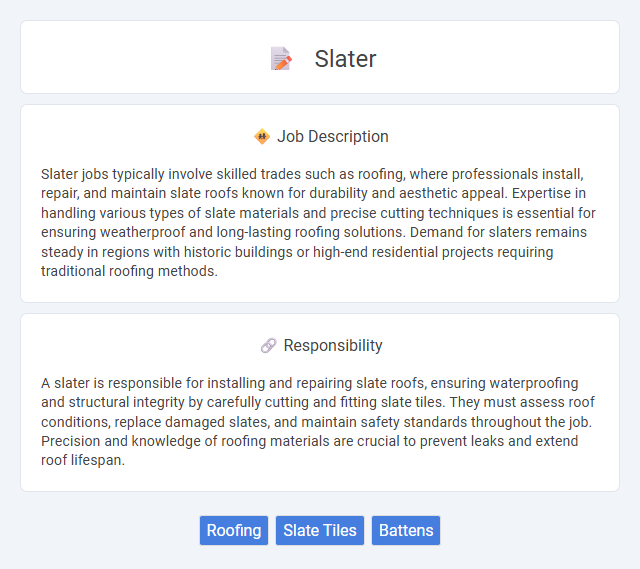
Slater jobs typically involve skilled trades such as roofing, where professionals install, repair, and maintain slate roofs known for durability and aesthetic appeal. Expertise in handling various types of slate materials and precise cutting techniques is essential for ensuring weatherproof and long-lasting roofing solutions. Demand for slaters remains steady in regions with historic buildings or high-end residential projects requiring traditional roofing methods.
Slater jobs likely suit individuals with physical strength and good stamina due to the demanding nature of handling heavy materials and operating machinery. People with strong attention to detail and the ability to follow safety protocols are probably better suited to reduce risks on the job. Those who struggle with physical labor or have limited coordination might find this occupation challenging and less appropriate.
Qualification
A slater requires specialized skills in cutting, shaping, and fitting slate tiles for roofing and cladding. Essential qualifications include experience with hand tools and power tools, knowledge of safety regulations, and the ability to read technical drawings and blueprints. Certification in roofing or construction trades, along with physical stamina and attention to detail, significantly enhances job performance and employability.
Responsibility
A slater is responsible for installing and repairing slate roofs, ensuring waterproofing and structural integrity by carefully cutting and fitting slate tiles. They must assess roof conditions, replace damaged slates, and maintain safety standards throughout the job. Precision and knowledge of roofing materials are crucial to prevent leaks and extend roof lifespan.
Benefit
Working as a slater probably offers significant financial benefits due to steady demand in construction and roofing projects. The role may provide opportunities for skill advancement and specialization, potentially increasing earning potential over time. Benefits often include hands-on experience with durable materials and improving physical fitness through active labor.
Challenge
Working as a slater likely involves facing the challenge of working at heights, which demands strong safety awareness and physical agility. The precision required in cutting and fitting slate tiles may pose difficulties, requiring steady hands and keen attention to detail. Weather conditions could also affect productivity, increasing the complexity of completing projects on time.
Career Advancement
A career as a slater offers robust opportunities for advancement through skill specialization in roofing techniques and materials such as natural slate and synthetic alternatives. Mastery of complex installations, repair, and restoration projects enhances employability and positions workers for supervisory or project management roles within construction companies. Continuous professional development and certifications in health and safety protocols further accelerate career growth in this niche trade.
Key Terms
Roofing
A slater specializes in installing slate roofing, a durable and long-lasting material known for its fire resistance, natural appearance, and ability to withstand harsh weather conditions. They measure, cut, and fit slate tiles precisely, ensuring proper alignment and waterproofing to protect structures from leaks and damage. Expertise in handling tools like slate knives and hammers, combined with knowledge of roofing frameworks, is essential for maintaining the integrity and aesthetic appeal of slate roofs.
Slate Tiles
Slate tiles offer exceptional durability and natural beauty for roofing and flooring projects. Known for their resistance to weathering, slate tiles provide a long-lasting, low-maintenance solution that enhances architectural aesthetics. Their unique texture and color variations make them a preferred choice for both residential and commercial applications.
Battens
Slater jobs often involve the precise installation and alignment of battens, which are essential for securing roofing materials such as slates and tiles. Battens, typically made from treated timber or metal, provide a stable framework that ensures proper spacing and ventilation under the roofing surface. Accurate batten placement directly impacts the durability and weather resistance of the roof, making their role critical in high-quality slate roofing projects.
 kuljobs.com
kuljobs.com